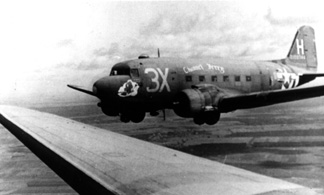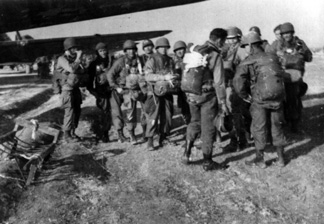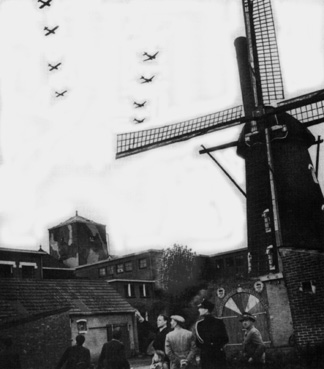Chapter 1
Diary Notes
Page 2 of 2

L to R: Pilot Norman Arvidson and
remaining crew, unidentified.
The Disney “Snoopy” cartoon was soon removed on
arrival overseas, by order of Higher Headquarters.
This was true of allsimilar mission aircraft.
|
Moving on to the War Zone: Soon thereafter, we departed by train from our home station, stripped down to our personal effects and gear, to pick up “our” brand new Douglas C-47 Dakota and began our final preparations to depart for overseas — but, where overseas? We later learned that our route to Europe would be via; Miami, Fl.; Puerto Rico; British Guyana; Natal, Brazil; Ascension Island, Liberia for a gas stop, 1200 gallons (the aircraft burned 90 gallons per hour); Dakar; Marrakech, Morocco for a nine day layover for crew rest. Then up the Atlantic to Liverpool, England and on to Greenham-Commons Air Base, our first front line combat station. |
| We were assigned to the 87th Troop Carrier Squadron of the 438th Troop Carrier Group, based at Greenham Commons
We remained at Greenham-Commons from February 1944 to January 1945 and then moved on to Rheims, France from January 1945 until July 1945.
Photo Right:
Norm Arvidson pilot of C-47 in view.
|
|
Aside from flying a great variety
of support missions during
our overseas tour,
the most serious combat flying
we were involved in included:
0 — 6 June 1944, D-Day: The first mission to St. Mere Eglese area.
0 — 6 June 1944, D-Day: (Fog)
Second mission, towed gliders
with troops and heavy
equipment.
Photo, Right:
Captain Norman Arvidson walks from quarters to truck that will carry him and his crew out to the flight line as they prepare to launch the invasion of Europe.
Greenham-Commons Air Base
6 June, 1944.
|
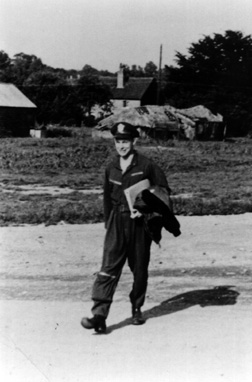
|
|
Photo Right:
C-47 “Dakota”
Troop Transports
prepared for lift-off
for the invasion of
France across the
English Channel
|
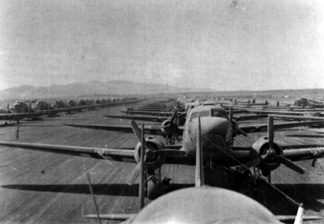
|
|
Photo Right:
Paratroopers preparing for an air drop during the fall season of 1944. They take great care in the inspection of each other’s equipment.
|
|
0 — Five days later, flights behind Omaha Beach, St. Lo, France
& Remagan Bridgehead.
0 — Liberated Paris, August 26, 1945
0 — 17 and 18 September (I think?): Two days to invade Holland. Horrible!
“Read the book
“A Bridge to Far” and “Battle Operation
Market Garden”.
This battle was so ugly! You will seldom hear
of it. A General Montgomery
mistake. One bullet missed my right wing fuel tank by 1/4 inch. The
“Holland Battle” — lots of dents and it was like being in a hail storm —
Very Loud!
Right:
C-47s, with CG-4A Gliders
in towe, over Holland
|
|
Editors Note:
If you would like to read a variety of details relating to
“Battle Operation Market Garden,”you may click on this URL
address and find a wide choice of selections and then return
to this page via use of your “back button.” The URL is
http://www.google.com/search?hl=en&lr=&ie=ISO-8859-
1&safe=off&q=Battle+Operation+Market+Garden&btnG=Google+Search

The invasion of Holland was attempted by air on Sept. 17, 23 days after Paris was
liberated. Eisenhower used his airborne forces to spearhead a dash for the north
German plains before winter set in. Here waves of U.S. paratroops drop near Grave
as livestock graze beside gliders that had landed earlier. The British 1st Airborne
Division was dropped at Arnhem; the American 82nd and 101st
near Nijmegen and Eindhoven.
Photo ctsy “Life’s Picture History of World War II”
|
0 — Flights supporting the Battle-of-the Bulge,
Christmas Day. 1944, at Bastogne.
|
Map and text in this frame is provided ctsy
“Life’s Picture History of World War II”
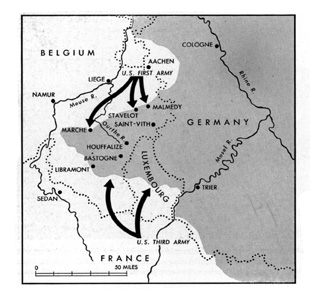
|
The Bulge was what Americans called a 50-mile wedge the Germans drove into their lines in December of 1944. Just when the U.S. First Army had been lulled into a false sense of security, Hitler struck through the fog-clouded Ardennes with most of his remaining armored reserves, gambling on capturing sufficient gasonline to gain Liege and Antwerp. He ordered three of von Rundstedt’s armies —the Seventh, and the Fifth and Sixth Panzers (ten tank divisions, 14 infantry) — to attack on Dec. 16 over a 75-mile front which was held by only five U.S. divisions. |
| Two great gaps were torn in the lines. Some new divisions were scattered, but the 2nd Infantry fought back heroically, as did the 7th Armored, which hung on grimly at St. Vith to split the German advance. The First Army turned south to block the way to Liege. Montgomery sent troops to prevent a Meuse crossing, and Patton struck hard against the southern flank. On Dec. 23 the weather cleared and the Air Forces began wrecking German tanks and trucks inside the Bulge. Early in January von Rundstedt withdrew, having lost more than 600 tanks and suffered some 90,000 casualties. |
Editors Notes:
1) Norman Arvidson received the DFC for being the only
pilot to get his plane to Bastogne on Christmas Eve to make a much
needed supply drop. His son, Ross, talked with a man at work in
Denver who said that his dad was at Bastogne and they waited all
day for needed supplies, finally one plane flew in and made a drop.
Ross asked if the dad could remember any markings on the plane
and the son said, “Yes, no name but a big 3X which was Norm’s
plane. When the crew returned to their base, the mess hall had
kept a Christmas dinner waiting for them. Fog and antiaircraft
fire kept other planes from completing their mission.
(See Chapter 6 for other WW II stories
told by Maj. Norman K. Arvidson.)
2) If you would like to read a variety of details relating to
“The Battle for Bastogne”you may click on this URL address
and find a wide choice of selections and then return to this
page via use of your “back button.” The URL is
http://www.trabel.com/bastogne/bastogne-battleforbastogne.htm
Our C-47 Dakota, Serial Number 2100744, carried us through our entire
WW II combat and transport flying service experience. We took delivery
in Michigan on 1 January 1944 and returned to the US for the last time
in July 1945. During that time we flew the Atlantic five times, both the
Northern and Southern routes, and made frequent flights overseas that
included England, Europe, the Mediterranian (including Italy and Africa).
During this time we had replaced the elevators and rudder on the tail
section, a few new wing tips and, on one occasion, a complete new wing.

